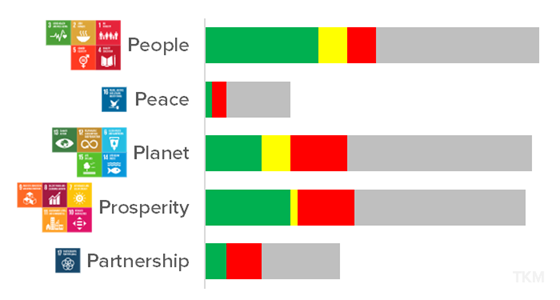Central Asia - Turkmenistan

Turkmenistan has made progress in achieving the Sustainable Development Goals (SDGs) since adopting the agenda in 2015. Turkmenistan has undertaken various initiatives to promote sustainable development, such as improving access to clean water and sanitation, and increasing renewable energy use. In 2019, Turkmenistan presented its first Voluntary National Review 2019 at the United Nations High-Level Political Forum on Sustainable Development. The review provided an overview of the country’s progress in implementing the SDGs and identified priorities for future action. In 2023 Turkmenistan releases its Second Voluntary National Review 2023, which tracked progress towards SDGs and provided comprehensive overview of SDGs integration into national development programmes and budgets.
Progress in SDGs

Based on Global SDG Indicators and Diagnostics 🟩 On Track 🟨 Mixed / For Review 🟥 Off Track ⬛ Trends NA
Integration of Sustainable Development Goals into national development programmes
In view of its comprehensive nature, the 2030 Agenda stipulates the transformation of national policies, strategies, concepts and plans for the socio-economic development of the country . This, in turn, requires the incremental implementation of SDG objectives into national policy. Concurrently, in order to effectively integrate the principles of sustainable development into national policy, a systematic audit should be conducted.
In order to determine the relevance of the SDG applicability in the context of the country, three Rapid Integrated Assessments (RIA) of existing national programmes were conducted in 2017, 2019 and 2022 with the assistance of UNDP. During the first two assessments, the policy documents adopted in the period 2010–2019 were analyzed, the implementation period of which was mainly planned until 2020 inclusive. According to the results of the assessments, a high level of integration (conceptually) of the SDG targets adopted by Turkmenistan in the current national policy documents, namely, 84% in 2017 and 85% in 2019 was revealed. In recent years, Turkmenistan has adopted a number of new long and medium term policy documents. In this regard, as part of the preparation to the Review, a third Rapid Integrated Assessment was carried out in 2022. Twenty four policy documents were selectively analyzed within the RIA. A rapid assessment of mapping the compliance of existing policies in Turkmenistan with the SDGs has shown that a level of integration of SDG targets into strategies, programmes and action plans remained as high as 85%.
SDG Accelerators
🔷 2.3. The agricultural productivity and rural development. Target 2.3, focusing on food security and agricultural productivity, holds significant importance for Turkmenistan for ensuring food security of the country. Despite significant progress in reducing prevalence of children stunting (from 11.5% in 2016 to 7.1% in 2019 according to MICS-5 and MICS-6), prevalence of anaemia among women remain high (around 27%, according to WHO/GHO estimates), reflecting the need to further address the issues of food security (Target 2.2).
Access to safe and nutritious food improves health outcomes and benefits educational achievements. Moreover, it links closely to SDG 8, creating employment and contributing to rural economic growth. Target 2.3 aligns with SDG 12’s emphasis on sustainable consumption and production, promoting sustainable food systems and waste reduction. By building resilient agricultural practices (Target 2.4), including guarantee of women’s rights to access and control resources (Targets 1.4, 5.a), Turkmenistan can mitigate climate change impacts and support climate action (Goal 13), while maintaining viability of ecosystems, especially water ones (Goals 6, 14, 15).
Ultimately, ensuring food security fosters social stability, reduces conflicts arising from food scarcity, and promotes effective food governance.
🔷 3.4. Reduce mortality from noncommunicable diseases. Non-communicable diseases are play important role in health in 8 out of 10 main causes of death in Turkmenistan, top three are Ischemic heart disease, Stroke, and Cirrhosis (according to the Global Burden of Disease Study 2019). Mortality rate attributed to cardiovascular disease, cancer, diabetes or chronic respiratory disease (probability) in Turkmenistan showed fair progress, but acceleration is required to reach target level 19%.
Premature mortality from non-communicable diseases is affected by metabolic factors (high blood pressure, high body mass index), behavioral risks (malnutrition, dietary risks, SDG 2.2), as well as environmental risks (SDGs 14, 15).
Access to quality infrastructure, especially water and sanitation (Targets 6.1, 6.2, 11.1), improving economic outcomes (Targets 8.1, 8.5, 8.6) and inclusion (Targets 10.1, 5.5, 1.5) play important role in reducing these risks. Well functioning health institutions (SDGs 3, 16) play crucial role in prevention of mortality.
Excessive mortality takes a heavy toll on economic growth (Goal 8) by reducing labor force and exacerbating inequalities, which requires social protection policies (Goals 5, 10)
🔷 4.4. Skills for employment. In Turkmenistan, SDG target 4.4 aims to ensure technical and vocational skills, for employment, decent jobs and entrepreneurship through equal access to quality technical, vocational, and tertiary education. Turkmenistan shows high 13.2 expected years of schooling in 2021. Quality of education and equal access remain priorities. SDG 4.4 has important interlinkages with other SDGs, especially Goal 8 trough improving employability, reduced skills mismatch, and ensuring future-readiness of the people in the workforce, and ultimately increase social wellbeing.
This will promote equal access to labour market for women/girls and men/boys—gender differences remain evident in particular on female-to-male education and seats held by women in national parliament. This will further empowerment of women to participate into the local labour market including by enhancing their access to STEM and ICT education (Targets 5.5, 5.b). Quality technical education will equip individuals with skills aligned with labour market demands, fostering decent work and economic growth (Goal 8).
Ultimately, equal access to technical education will reduce inequalities and promote social inclusion (Goal 10).
🔷 6.1. Universal and equitable access to safe drinking water. In Turkmenistan almost everyone (99.9% in 2019 according to MICS-6) is using safely managed drinking water services. Access to safe and affordable drinking water is closely linked with achievement of health targets (Goal 3), both related to communicable diseases and noncommunicable diseases. Sustainable water management closely linked with sustainable urbanization (Targets 1.4, 11), sustainable agriculture (Goal 2), industrialization (Goals 8, 9, 12), and gender equality and women’s empowerment (Goal 5, esp. 5.1, 5.2, 5.4, 5.5, 5.a).
However, there are evident trade-offs between SDG targets. Water in Turkmenistan is actively used in agriculture, leading to high levels of water stress (withdrawals absorbed 87% of available freshwater resources in 2021, according to VNR2023). Climate change (Goal 13) makes access to safe and affordable drinking water for all a challenging task. Industrialization and especially oil and gas exploration (Goals 8, 9) increases the risks from toxic waste.
🔷 8.5. Full and productive employment and decent work. In Turkmenistan context the SDG Target 8.5 aligns with the goal of increasing population wellbeing. By promoting decent work, Turkmenistan can contribute to improvement of life quality by providing individuals with opportunities for sustainable income generation and economic empowerment. By ensuring adequate skill formation (Targets 4.4, 4.3), promoting employment opportunities (Target 8.3) with fair wages, job security (Targets 8.8), and social protection (Goal 10), and addressing low rates of women’s employment, including through STEM and ICT education (Targets 5.5, 5.b), Turkmenistan can create a more productive workforce.
Job creation is closely linked with sustainable industrialization (Target 9.2). Despite recent improvements, manufacturing value added as a proportion of GDP capita declining in Turkmenistan (from peak 52.3% in 2012 to 32.5% in 2022, according to UNSTAT data from UNIDO).
However, the pursuit of economic growth and industrialization also entails trade-offs. It requires careful consideration of environmental sustainability, as industrial activities can have adverse ecological impacts—affecting ecosystems (Goals 15, 2), potable water (Goal 6), health of people (Goals 3). Rapid industrialization could put pressure on energy access (Targets 7.2) at the expense of energy sustainability (Targets 7.2, 7.3). Ensuring inclusivity in this process is crucial to prevent potential social, gender, and territorial inequalities (Goals 10, 5)
The dynamic map shows SDG Accelerators for Turkmenistan.
Use buttons to highlight certain paths and Focus to explore certain targets
See 📊 SDG Push Diagnostic for Turkmenistan
Read the 📑 Integrated SDG Insights Report for Turkmenistan
Voluntary National Reviews
🌐 Voluntary National Review 2023
🌐 Voluntary National Review 2019
